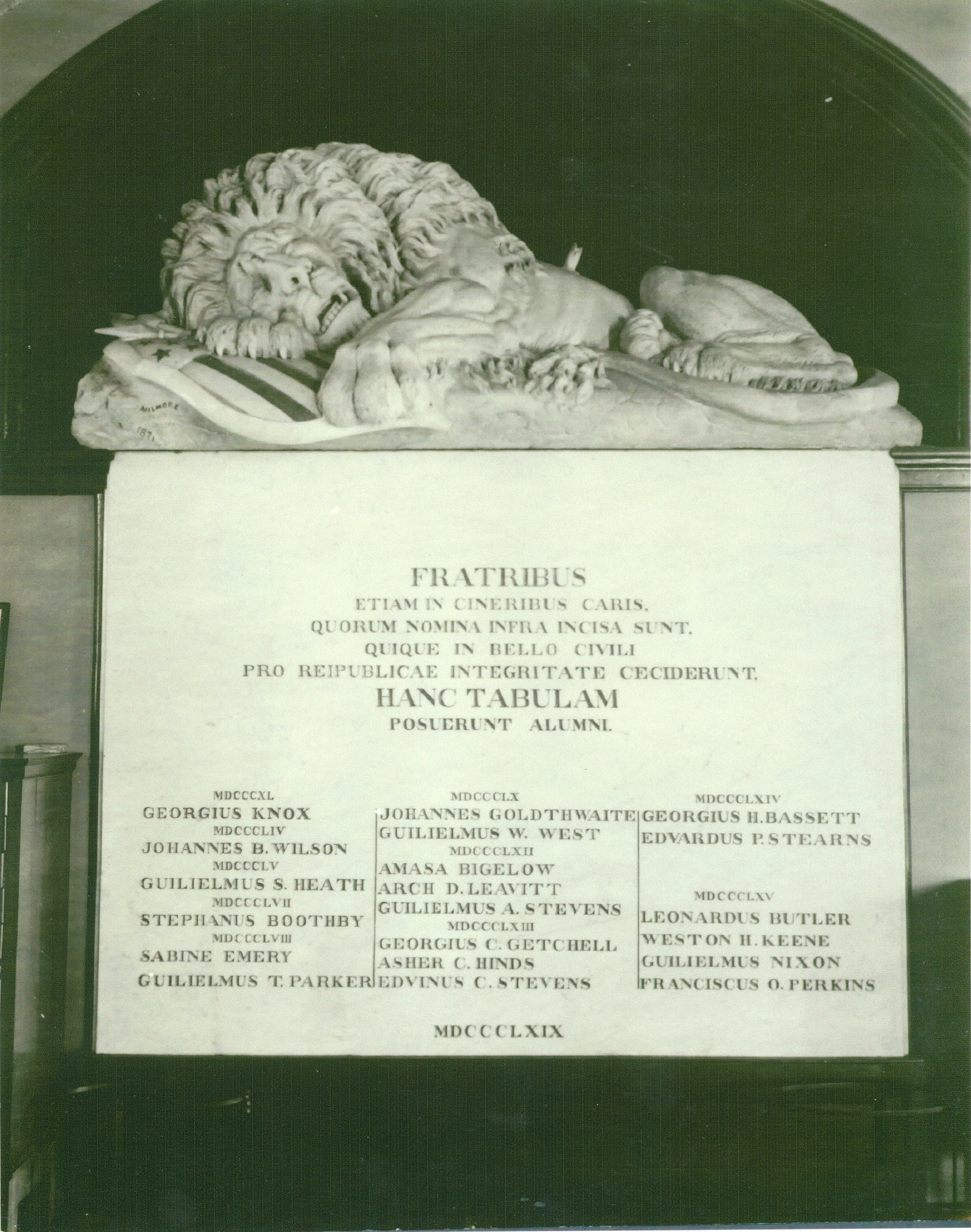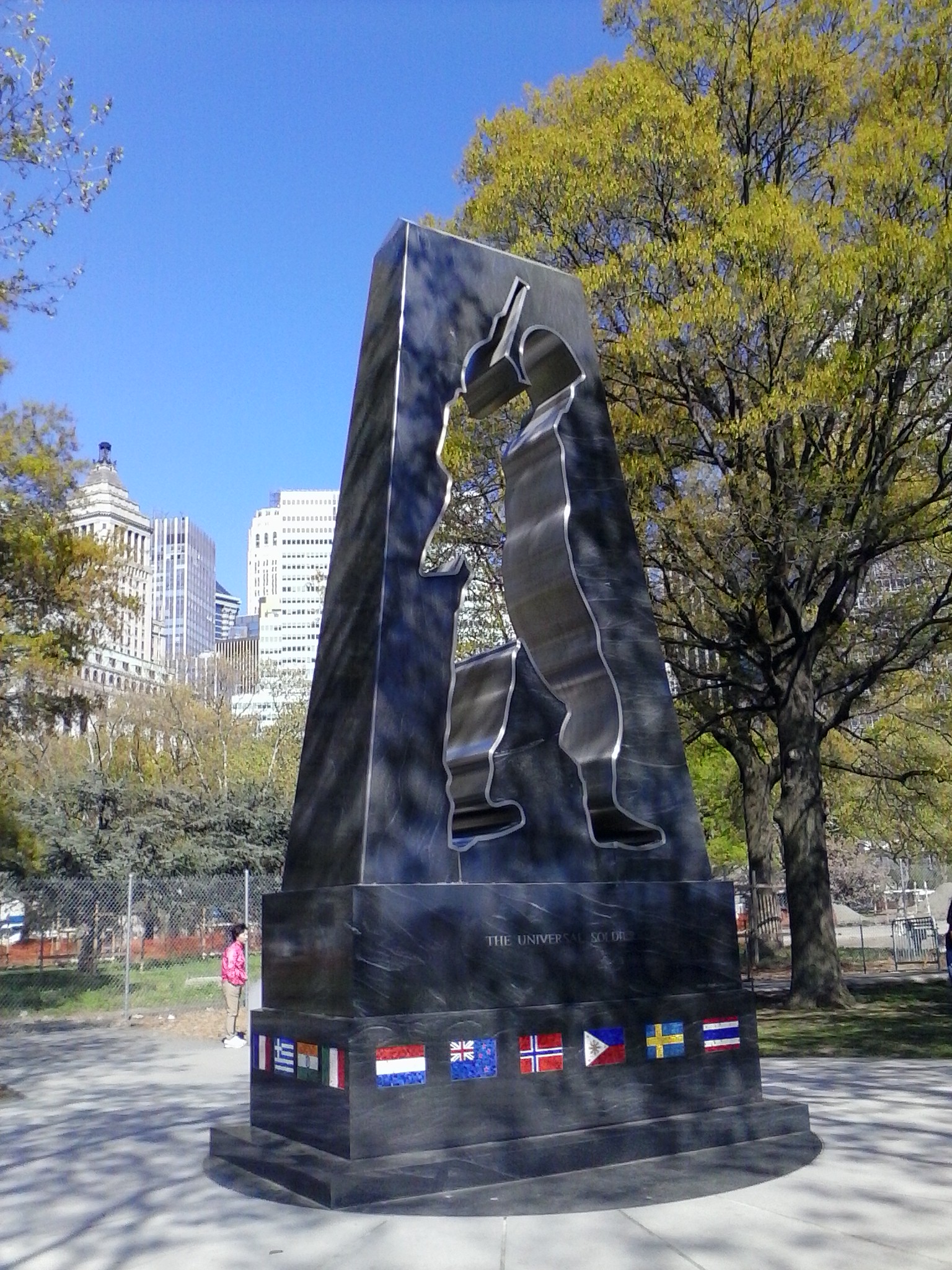I used to work, years ago, down by Battery Park. On pleasant days I’d get a sandwich for lunch and go sit on a bench there to eat it.
In those times — the late 70s — it was your usual seedy New York park, tired parched grass interspersed with patches of bare dirt, and guys selling loose joints, and fetching Italian keypunch chicks taking in a bit of sun. I well remember the Summer Of Horizontal Stripes, when lycra was still a new thing.
There were a couple of war memorials in the park then. One rather grand one consisted of a double row of big stone monoliths, with the names of all the Navy men and (I think) merchant seamen lost at sea during World War Two inscribed on them. It was rather stodgy in design — very Fifties — and featured a most unfortunate nasty-looking eagle, if memory serves, hunkered down in a resentful pose at the end of the aisle. But at least it had the virtue of sobriety and restraint, and all the names after names gave one food for thought. And then too the axis of the aisle was unobtrusively aligned on the statue of liberty across the harbor. There was nothing to point this out, or beat you over the head with it. After a few lunchtimes there, you noticed. As war memorials go, not bad. Not as good as this one, below, but not bad:

The lion — a copy, apparently, of one in Lucerne — used to occupy a place of honor in Colby College’s Memorial Hall. Now it’s in a sterile undistinguished space in the basement of the library, which seems a bit of a comedown. But it’s still pretty impressive.
Since my days of lunching (and ogling Italian girls) in Battery Park, some other monumwents have been added. There’s one to the merchant mariners of WWII, a very lugubrious affair, showing three big bronze guys on what appears to be a sinking bronze deck, and the hand of a fourth bronze guy, clearly a goner, reaching up out of the water. The hand is all you see of this fourth guy. He appears to know the answer to the last question Teacher will ever pose him. Ask me! Ask me! Before it’s too late!
There is a tablet nearby which notes that the sculpture group is based on a photo of sailors on a bit of wreckage from a torpedoed ship. The tablet also records, with a strange note of grim lip-smacking relish, that the sailors in question were not rescued, and subsequently went down with their vessel.
There is a monument to the Norwegian merchant marine, also during world war II. This consists of a roundish stone sitting on top of a flattish stone. Enigmatic people, those Norwegians. But one is glad for a respite from bronze.
And then there is the monstrosity shown up top. This is the Korean War memorial. Dunno if you can see the inscription; it reads, THE UNIVERSAL SOLDIER. There are earnest little national flags, picked out in clumsy childish mosaic, surrounding the base. I assume these were the various “allies” in the Police Action.
Questions crowd to mind. Who on earth came up with this misbegotten idea? What had he or she been doing the night before? How did the committee come to pick this one? What, in God’s name, were the other ideas?
Now the Korean War was a hell of a bad idea, and the soldiers who died there died very much in vain, I think. But they certainly deserve better than to be remembered with the title of a pop song and represented as a void — a lumpish, badly-drawn void at that.


SPLURRRTTT HA HA HA HA HA HA HA HAAAHHHHH.
Goddammit, Smiff, you owe me a new keyboard.
Christ, that’s not a war memorial; it’s a sight gag from an old Chuck Jones cartoon. I quite agree, that’s world-class st00pid.
Still, if you want stupidity on a grand scale, you can’t beat the recently-inflicted WWII memorial down here in ol’ DC — a shallow, piss-poor simulacrum of the classic Washington memorials of the late 19th and early 20th Centuries. If you haven’t seen it, it’s the one that looks as if the architect was channelling Albert Speer — the one which, if you didn’t know better, would make you think that the Germans won the war.
This little pop-art stinkburger, though… this is positively gobsmacking bad.
This cult of war memorials is quite a new invention, in most cases not much more than a hundred years old (i.e. aftermath of “the Great War”):
http://www.leithart.com/archives/002626.php
Soldiers were regarded as low-grade crooks until the Frenchies rounded up their fellow countrymen in the Levée en masse leading to far bloodier wars than the relatively straightforward jousting of yore. As the voiceover in Kubrick’s Barry Lyndon noted:
I have the impression that war memorials in the US got going pretty soon after the Civil War. I can’t think of any memorials to earlier wars that predate the Civil War — I mean, where the memorials themselves predate the Civil War. Though no doubt there are some.
If the fad got going “pretty soon after the Civil War” then I must have missed it. It felt more like at least a generation and in many cases more like two (i.e. 50th anniversaries of start and end as celebrated by war buffs) before anything was erected. It was part of the great mythic victory of the South over perfidious Yankees waged not by cannon and rifle but through the medium of gigantic monuments and profusely worded statues. The wording on these is itself a source of entertainment and James Loewen had a good time researching his book titled Lies Across America“.
Here’s the sort of thing I was thinking about, from Boothbay, Maine. 1879. http://www.maine.gov/civilwar/images/Boothbay01.jpg
Who is this guy? They were besotted with “Great Man” theories in the 19th century and statues of such movers and shakers were fairly common. It was only in the 20th century that traditions such as Tomb of the Unknown Soldier were invented:
http://en.wikipedia.org/wiki/Tomb_of_the_unknown_soldier
This makes me think of a cookie cutter… soldiers as gingerbread men… maybe it is intentional.